 KANAZAWA KUTANI-WARE
KANAZAWA KUTANI-WARE
The history of Kanazawa Kutani-ware starts in 1807 when ceramist Mokubei Aoki was invited to Kanazawa by the Kaga Clan from Kyoto. After his establishment of a kiln in Mount Kasuga, Kanazawa Kutani-ware developed sporadically, each distinctive period reflecting the atmosphere of the times in which it was produced.
Urbanized and slightly high-graded among the other Kutani-ware, Kanazawa Kutani-ware now is made using electric or gas kiln centering around Kanazawa.
Traditionally, Kutani is known for its bright, five-colored (blue, navy blue, yellow, purple, and red) over-glaze patterns, but today much broader variety of color is used, moreover more ceramists tends to make good use of the soil color itself rather than using the bright colors.
 Process of Kutani-ware
Process of Kutani-ware
|
|
quarry out potter's stone |

|
|
|
|
grind the stone into fine earth. |

|
|
|
|
soak the earth in water to remove floating material, such as iron. |

|
|
|
|
suck up extra water to soften the clay. |

|
|
|
|
remove air inside the clay which causes cracks and strains. |

|
|
|
|
form with potter's wheel.
form with molding. |

|
|
|
|
put pedestal and knob.
finish brim. |

|
|
|
|
fire it at 800 degrees centigrade for 8 hours. |

|
|
|
|
draw an outline with "Sometsuke-gosu"
(dark blue paint) made of cobalt oxide. |

|
|
|
|
enamel the surface of pottery. |

|
|
|
|
fire at 1300 degrees centigrade for more than 15 hours. |

|
|
|
|
draw hairline with Gosu.
paint with five color paints. |

|
|
|
|
fire between 800 and 1000 degrees centigrade. |

|
|
Firing for gold and silver
|
|
paint gold and silver and fire at 400 degrees centigrade. |
|
|
 Painting Style
Painting Style
|
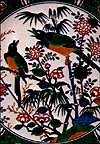 KO-KUTANI (about 330 years ago)
KO-KUTANI (about 330 years ago)
This style prospered under the guidance of Morikage Kusumi, expert of the Kano
school of Japanese painting. It is characteristic of mighty and lovely design and
flowing hairline with five color paints (green, yellow, red, purple, dark blue). |
|
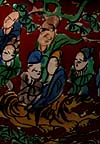 MOKUBEI (about 180 years ago)
MOKUBEI (about 180 years ago)
After the decline of the Ko-kutani, the Kasugayama kiln was founded. Mokubei
Aoki, painter in kyoto is said to have led the style. Ground is generally painted
red and figure of Chinese style is preferred as an object. |
|
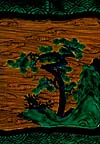 YOSHIDAYA (about 165 years ago)
YOSHIDAYA (about 165 years ago)
This is a style of Ko-Kutani origin, painted all over with four colors except red
with small pattern as ground, showing profound atmosphere. |
|
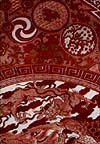 IIDAYA (AKA-E) (about 150 years ago)
IIDAYA (AKA-E) (about 150 years ago)
This is a minute painting of figure with the color of red as ground and gold in
places. |
|
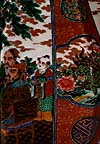 SHOZA (about 135 years ago)
SHOZA (about 135 years ago)
This is the main style of today with all styles putting together. The
"Saishiki-kinrande" is characteristic of it. |
|
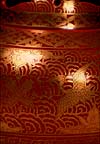 EIRAKU (about 120 years ago)
EIRAKU (about 120 years ago)
This is a gorgeous style with red as ground and gold showing refined beauty of
"Kyo-yaki" style led by Wazen Eiraku. |
|

|